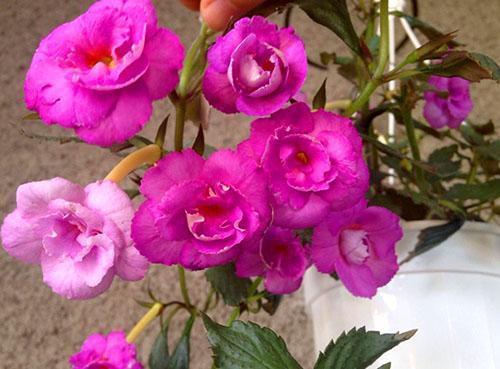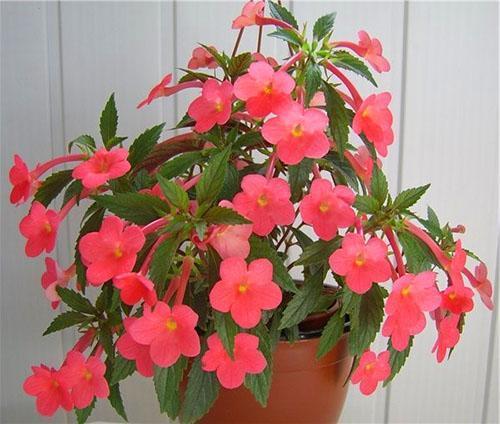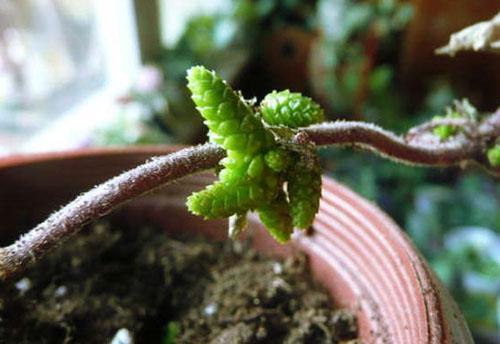We study different ways of reproduction of Achimenes
 Loved by many, decorative, profusely blooming achimenes can be easily diluted on its own. If you believe the esotericists, the best examples of houseplants are obtained by cultivating with your own hands. It is believed that by composing the substrate, preparing it for planting, working with seeds, roots, cuttings, the amateur charges the plants with positive, tames them in advance. Therefore, such plants are more responsive to care, and forgive the fan for minor flaws. Read also:achimenes - care and cultivation!
Loved by many, decorative, profusely blooming achimenes can be easily diluted on its own. If you believe the esotericists, the best examples of houseplants are obtained by cultivating with your own hands. It is believed that by composing the substrate, preparing it for planting, working with seeds, roots, cuttings, the amateur charges the plants with positive, tames them in advance. Therefore, such plants are more responsive to care, and forgive the fan for minor flaws. Read also:achimenes - care and cultivation!
Achimenes breeding methods

- rhizomes, root formations;
- stem cuttings;
- leafy cuttings;
- scales with rhizome;
- air rhizomes:
- stolons;
- peduncles and calyxes of flowers;
- seeds.
Of course, not all methods are equally effective; the easiest ones are preferred. But if even a millionth plant takes root with one sepal, the genus will not die.
 Rooting by rhizomes, their scales and air cones does not raise questions from amateurs. These methods are clear, but we know how to root nodules of flowers. However, there are times when the flower has caught the eye at the most inconvenient time when the roots cannot be disturbed.
Rooting by rhizomes, their scales and air cones does not raise questions from amateurs. These methods are clear, but we know how to root nodules of flowers. However, there are times when the flower has caught the eye at the most inconvenient time when the roots cannot be disturbed.
 There are other breeding methods as well. They all lead to the moment when Achimenes falls into a dormant period. It is by this time, in one way or another, that rhizomes should form on a young plant, enter into a state of rest. Therefore, the early rooting time of the new planting will be decisive.
There are other breeding methods as well. They all lead to the moment when Achimenes falls into a dormant period. It is by this time, in one way or another, that rhizomes should form on a young plant, enter into a state of rest. Therefore, the early rooting time of the new planting will be decisive.
Propagation of Achimenes by cuttings
 Experts warn that this method can be beneficial if applied in the spring, when there is enough time for root development. In this case, any part of the branch is used, since some experts write about the rooting of the lower and middle parts, others suggest using the top with the resulting flowers.
Experts warn that this method can be beneficial if applied in the spring, when there is enough time for root development. In this case, any part of the branch is used, since some experts write about the rooting of the lower and middle parts, others suggest using the top with the resulting flowers.
 For cutting Achimenes, we use a twig, cutting three cuttings from it. We remove a couple of lower leaves from the upper cutting, because it is here, after rooting, that rhizomes will grow by autumn. On other segments, there should be at least 3 internodes, from which we will also remove the lower leaves. You can take only the apical shoot, leaving the stem to grow further.
For cutting Achimenes, we use a twig, cutting three cuttings from it. We remove a couple of lower leaves from the upper cutting, because it is here, after rooting, that rhizomes will grow by autumn. On other segments, there should be at least 3 internodes, from which we will also remove the lower leaves. You can take only the apical shoot, leaving the stem to grow further.
All actions for cuttings, cutting, preparation of the substrate are accompanied by the disinfection of tools, dishes and planting soil. A prerequisite for reproduction is warmth, the best results are with lower soil heating.
 All plant sections must be sprinkled with crushed coal or cinnamon powder to dry. Dip the part where callus will form in a root formation stimulator, if rooting occurs in a sandy layer, peat tablet, in water or special substrate:
All plant sections must be sprinkled with crushed coal or cinnamon powder to dry. Dip the part where callus will form in a root formation stimulator, if rooting occurs in a sandy layer, peat tablet, in water or special substrate:
- perlite;
- vermiculite;
- peat or coconut fiber;
- sand.
The main thing is that the mixture is airy, moist and warm. If there are few plants, it is better to root them in small cups or in tablets. All Achimenes made from cuttings must be placed in a mini-label, which can be a plastic bag.It is only necessary to ventilate the cuttings.
 If everything goes well, roots will appear in 2 weeks and the plant can be transplanted into permanent soil, when rooting in a light mixture. In tablets and cups, the rastish can be left until the roots grow, then transplanted by the transfer method, without injuring the achimenes from the cuttings. After such rooting, by the fall, two small rhizomes on the sides will definitely grow, and the bush will be able to overwinter.
If everything goes well, roots will appear in 2 weeks and the plant can be transplanted into permanent soil, when rooting in a light mixture. In tablets and cups, the rastish can be left until the roots grow, then transplanted by the transfer method, without injuring the achimenes from the cuttings. After such rooting, by the fall, two small rhizomes on the sides will definitely grow, and the bush will be able to overwinter.
Leaf stalk
 Do not forget, we removed a few leaves when preparing the stem cutting. Now soak the slightly withered leaves in soft water and leave in a warm, bright place. The roots will appear, and we will arrange a leaf in a small glass with prepared earth. So we carry out the propagation of achimines by cuttings from leaves.
Do not forget, we removed a few leaves when preparing the stem cutting. Now soak the slightly withered leaves in soft water and leave in a warm, bright place. The roots will appear, and we will arrange a leaf in a small glass with prepared earth. So we carry out the propagation of achimines by cuttings from leaves.
 The leaf will also have time to give one or two rhizomes, which will please with flowering next season.
The leaf will also have time to give one or two rhizomes, which will please with flowering next season.
 Let's dwell on one more little-known method of propagation of Achimenes by cuttings. Amateurs experiment. The hostess did not allow to pinch off one of the specimens she liked, and the guest took away three cups of flowers with pedicels, and a couple that had already faded, with bracts and cups. Not hoping for a miracle, the lover put them in cups, they survived and gave birth to offspring.
Let's dwell on one more little-known method of propagation of Achimenes by cuttings. Amateurs experiment. The hostess did not allow to pinch off one of the specimens she liked, and the guest took away three cups of flowers with pedicels, and a couple that had already faded, with bracts and cups. Not hoping for a miracle, the lover put them in cups, they survived and gave birth to offspring.
 For the reproduction of rare species, you can use this method.
For the reproduction of rare species, you can use this method.
Reproduction by stolons
If a thin shoot passes in the soil almost on the very surface, this is a ready-made cutting of achimenes, which can be covered with soil without preliminary preparation. He is already ready, he also has scaly leaves, which are rooting. It happens that such a stem has already given several leaves, then this is a completely finished plant.
Ahimenes seed reproduction
 Seed propagation is often used by breeders trying to get hybrid forms. This is worth doing if there are several beautiful species, but you want to get even more beautiful. Then, during flowering, artificial pollination is carried out with a brush, but we do not have a caliber bird that pollinates these plants in nature. The seeds are poured and ripen for two months.
Seed propagation is often used by breeders trying to get hybrid forms. This is worth doing if there are several beautiful species, but you want to get even more beautiful. Then, during flowering, artificial pollination is carried out with a brush, but we do not have a caliber bird that pollinates these plants in nature. The seeds are poured and ripen for two months.
 The seeds are so small that they are almost invisible. For relief, they are mixed with sand and sifted over the wet surface of the prepared soil, moistened with a spray bottle and covered with foil. Seeds sprout quickly, in a week or two. The main thing is to keep warm at least 23 0 , and seedlings appeared in early February, so that the babies had time to develop and give a small scaly cone. Before germination, the bowl is regularly ventilated. The plants should not stretch out, they will immediately fall. Therefore, it is necessary to immediately provide additional lighting without overheating. As they grow up, they dive. At least three times in the spring. Then they are left in a small glass and looked after like an adult plant.
The seeds are so small that they are almost invisible. For relief, they are mixed with sand and sifted over the wet surface of the prepared soil, moistened with a spray bottle and covered with foil. Seeds sprout quickly, in a week or two. The main thing is to keep warm at least 23 0 , and seedlings appeared in early February, so that the babies had time to develop and give a small scaly cone. Before germination, the bowl is regularly ventilated. The plants should not stretch out, they will immediately fall. Therefore, it is necessary to immediately provide additional lighting without overheating. As they grow up, they dive. At least three times in the spring. Then they are left in a small glass and looked after like an adult plant.
 Reproduction of achimenes by seeds is labor-intensive, but does not guarantee a beautiful flower. Different copies may come out of the same batch, and beauty is not guaranteed. Vegetative and root methods are more reliable.
Reproduction of achimenes by seeds is labor-intensive, but does not guarantee a beautiful flower. Different copies may come out of the same batch, and beauty is not guaranteed. Vegetative and root methods are more reliable.
Soil composition and requirements for breeding utensils
 Ahimenes are unpretentious, but light soil is needed for the rapid development of the root system. Therefore, you can use an ordinary substrate for seedlings of garden plants, plant cuttings in peat pots, or root in special mixtures. The main condition will be the obligatory disinfection of the soil in one way or another.
Ahimenes are unpretentious, but light soil is needed for the rapid development of the root system. Therefore, you can use an ordinary substrate for seedlings of garden plants, plant cuttings in peat pots, or root in special mixtures. The main condition will be the obligatory disinfection of the soil in one way or another.
For primary germination, it is recommended to use a mineral composition of vermiculite, perlite and peat. And for a developed root system, soils are used based on humus, leafy earth and sand, with the addition superphosphate for the development of the root system. It is important to have a good drainage layer so that the water does not stagnate during irrigation. Top this layer can be sprinkled with crushed eggshells.
 If new plants are planted in small cups, then the drainage layer in them should not be less than 2-3 cm. For the development of the plant, a surface layer is needed, because the roots of Achimenes develop horizontally under a thin layer of earth.
If new plants are planted in small cups, then the drainage layer in them should not be less than 2-3 cm. For the development of the plant, a surface layer is needed, because the roots of Achimenes develop horizontally under a thin layer of earth.